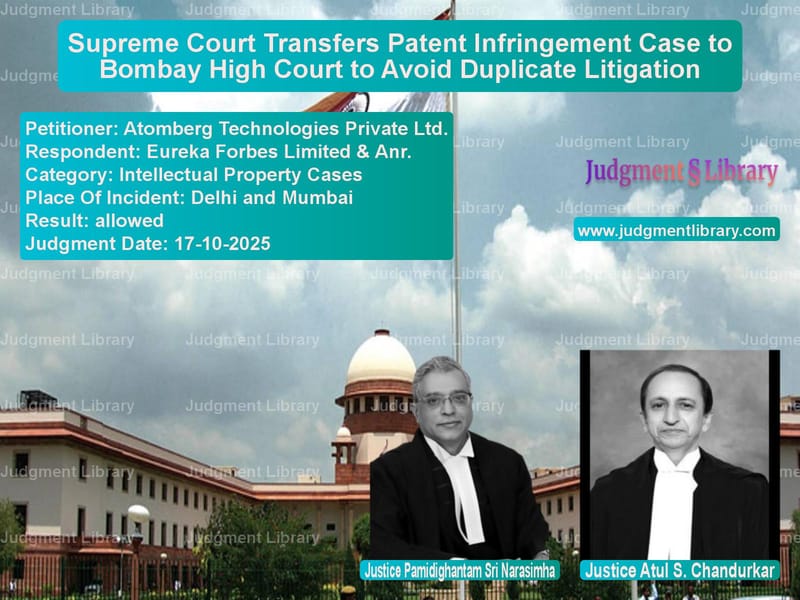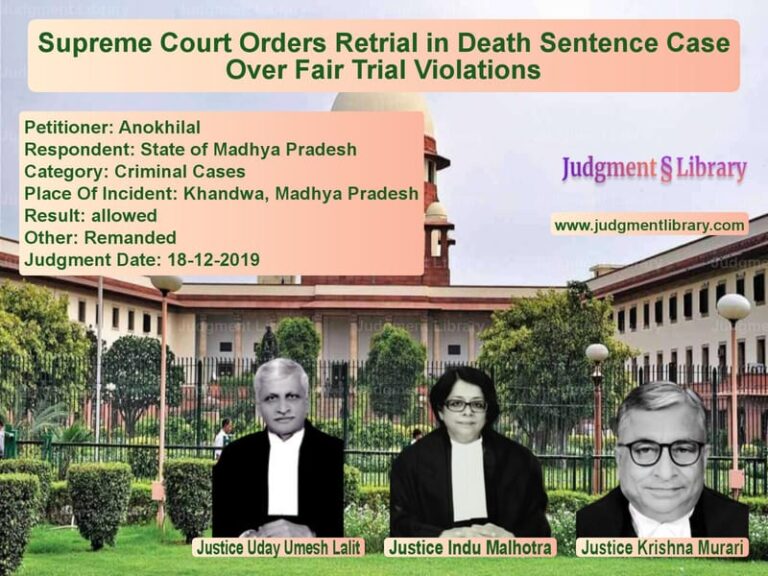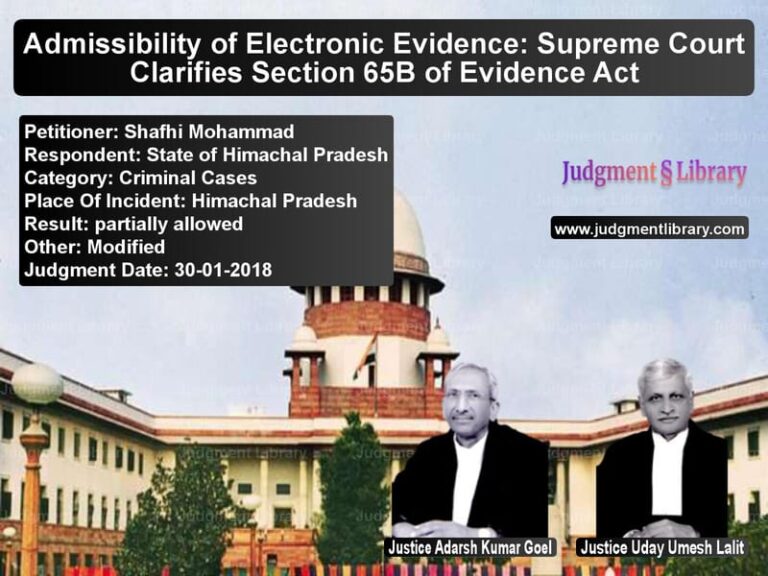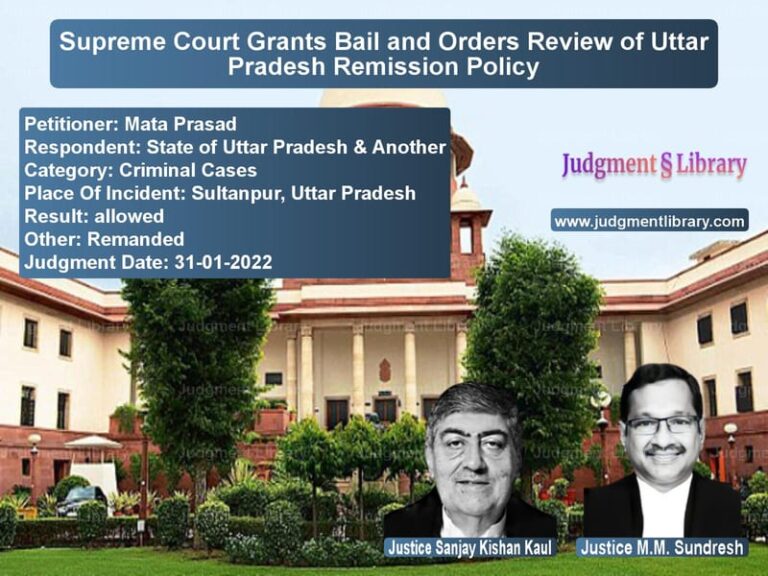Supreme Court Transfers Patent Infringement Case to Bombay High Court to Avoid Duplicate Litigation
On October 17, 2025, the Supreme Court of India delivered a crucial judgment that resolved a jurisdictional conflict between two major players in the home appliances industry. The case pitted Atomberg Technologies Private Ltd. against Eureka Forbes Limited in a patent dispute over water purifier technology. The legal drama unfolded across two cities—Mumbai and Delhi—with both companies racing to court to protect their interests. This ruling not only determines where the case will be heard but also sets important precedents for how patent disputes should be handled when multiple cases emerge from the same facts.
The story begins in June 2025 when Atomberg Technologies launched its new water purifier under the brand name “Atomberg Intellon.” Shortly after the product hit the market, Atomberg claims that Eureka Forbes began making threats to its business network. According to Atomberg, representatives from Eureka Forbes contacted Atomberg’s distributors and retailers, warning them that the new product infringed on Eureka Forbes’s patents and threatening legal action. These communications, described as oral threats, created what Atomberg called “apprehension and fear” among its business partners, potentially damaging its market position and business relationships.
In response to these perceived threats, Atomberg moved quickly to protect its interests. On July 1, 2025, the company filed what’s known as a “groundless threats” suit under Section 106 of the Patents Act, 1970, in the Bombay High Court. This type of legal action allows a company to seek protection when it believes another party is making unjustified legal threats about patent infringement. Atomberg’s position was clear: they wanted the court to declare that these threats were without foundation and to prevent Eureka Forbes from continuing this behavior.
Meanwhile, Eureka Forbes had its own version of events. The company claimed that it independently discovered that Atomberg’s new water purifier contained technology that mirrored its own patented innovations. Specifically, Eureka Forbes pointed to features like customizable taste settings and TDS adjustment modes as areas where patent infringement might have occurred. To establish its case, Eureka Forbes took an interesting approach—it purchased Atomberg’s product through an online portal and had it delivered to an address in Delhi. After examining the product, Eureka Forbes concluded that patent infringement had indeed occurred and filed its own lawsuit in the Delhi High Court on July 7, 2025, under Section 104 of the Patents Act.
With both companies having filed lawsuits in different cities, a procedural battle ensued. Atomberg petitioned the Supreme Court to transfer Eureka Forbes’s Delhi case to Bombay, while Eureka Forbes asked the Supreme Court to transfer Atomberg’s Bombay case to Delhi. This set the stage for the Supreme Court to determine which court should hear the combined dispute.
Atomberg’s Arguments for Transfer to Bombay
Atomberg presented several compelling reasons why the Delhi case should be transferred to Bombay. The company emphasized that “the suit filed by the petitioner for groundless threats of patent infringement in Bombay was instituted prior to the suit instituted by the respondent no.1 in Delhi for patent infringement.” This point about timing was crucial—Atomberg argued that since they filed first, their chosen forum should take precedence.
The company also highlighted geographical considerations, noting that “the petitioner and respondent no.1, have their registered offices in Mumbai, which is within the territorial jurisdiction of the Bombay High Court, making it the most appropriate forum for adjudication.” Essentially, Atomberg argued that since both companies are based in Mumbai, it made practical sense for the case to be heard there rather than in Delhi.
Perhaps the strongest accusation came when Atomberg claimed that “the respondent is deliberately engaging in forum shopping by filing the subsequent suit in Delhi. This attempt to invoke jurisdiction in Delhi is based solely on online purchases and delivery of the product to Delhi, which is an insufficient ground to create jurisdiction, especially when the parties have a longstanding business presence and offices in Mumbai.” This argument suggested that Eureka Forbes was strategically choosing a favorable court rather than following logical jurisdictional principles.
Atomberg also pointed out that “the issues involved in both suits substantially overlap. The Delhi Suit and the Bombay Suit raise identical questions of law and fact, especially concerning the alleged infringement of the patents in relation to the petitioner’s water purifier product.” This overlap meant that hearing the cases separately could lead to inconsistent rulings and wasted resources.
Eureka Forbes’s Arguments for Keeping the Case in Delhi
Eureka Forbes presented equally strong arguments for why their Delhi case should remain in Delhi and why Atomberg’s Bombay case should be transferred there. The company contended that “the suit pending before the Delhi High Court is the substantive suit and should be retained there for adjudication.” In their view, the Delhi case addressed the core issue of patent infringement, while the Bombay case was merely procedural.
The company emphasized that “the Delhi Suit concerns the core issue of patent infringement, which involves detailed factual and technical determination, and therefore demands the exercise of jurisdiction by the court having prima facie cause of action within its territorial limits.” Eureka Forbes argued that the technical nature of patent cases required a court that had a direct connection to where the alleged infringement was discovered—which they established through their online purchase and delivery in Delhi.
Eureka Forbes sought to minimize the importance of Atomberg’s Bombay case, stating that “the Bombay Suit instituted by the petitioner for groundless threats is procedural and limited in scope, merely seeking declarations and injunctions against threats without delving into the full merits of patent validity or infringement.” They characterized the Bombay suit as ancillary and unable to provide the comprehensive resolution that their Delhi suit could offer.
The company defended its choice of forum by arguing that “the respondent has not indulged in forum shopping, as the cause of action for infringement arose within the jurisdiction of the Delhi High Court. The online purchase and delivery of the petitioner’s product at Delhi suffices to confer territorial jurisdiction, consistent with legal principles governing patent infringement suits under Section 104 of the Patents Act and Section 20 of the Code of Civil Procedure.” This positioned their Delhi filing as legally justified rather than strategically motivated.
The Supreme Court’s Reasoning and Decision
The Supreme Court carefully weighed these competing arguments while acknowledging the limited scope of its authority in transfer petitions. The judges recognized that both cases stemmed from the same underlying dispute and involved substantially the same parties, facts, and legal questions.
In its analysis, the court made several key observations. First, it noted that Atomberg’s Bombay suit was filed on July 1, 2025, while Eureka Forbes’s Delhi suit came six days later on July 7, 2025. This timing gave Atomberg’s case chronological priority. Second, the court examined how Eureka Forbes had established jurisdiction in Delhi—through an online purchase and delivery—and contrasted this with both companies having their registered offices in Mumbai. Third, and most importantly, the court found that “the question of fact, law, and the issues to be determined in the suit for groundless threat of infringement instituted by the petitioner and the suit for infringement instituted by the respondent no. 1 are substantially overlapping.”
The court drew guidance from its earlier decision in Chitivalasa Jute Mills v. Jaypee Rewa Cement, where it had allowed a transfer petition in similar circumstances. The judges quoted from that case: “On the facts averred in the two plaints filed by the two parties before two different courts, it is clear that the parties are substantially the same. The fact remains that the cause of action alleged in the two plaints refers to the same period and the same transactions. What is the cause of action alleged by one party as foundation for the relief prayed for and the decree sought for in one case is the ground of defence in the other case. The issues arising for decision would be substantially common. Almost the same set of oral and documentary evidence would be needed to be adduced for the purpose of determining the issues of facts and law arising for decision in the two Suits before two different courts. Thus, there will be duplication of recording of evidence if separate trials are held. The two courts would be writing two judgments. The possibility that the two courts may record findings inconsistent with each other and conflicting decrees may come to be passed cannot be ruled out.”
This reasoning proved decisive in the current case. The Supreme Court concluded that consolidating the cases in Bombay would serve the interests of justice by preventing duplication of effort, conserving judicial resources, and avoiding the risk of conflicting judgments. The court allowed Atomberg’s transfer petition, directing that the Delhi suit be transferred to the Bombay High Court to be tried alongside Atomberg’s original suit. Consequently, the court dismissed Eureka Forbes’s counter-petition seeking to transfer the Bombay case to Delhi.
The Supreme Court’s decision represents a significant development in how Indian courts handle parallel litigation in intellectual property disputes. By prioritizing efficiency and consistency over technical jurisdictional arguments, the court has sent a clear message that the judicial system should avoid unnecessary duplication when the same fundamental dispute appears in multiple courts. This approach benefits not only the parties involved but also the broader legal system by ensuring that precious judicial resources are used effectively. The ruling also acknowledges the practical realities of modern commerce, where online transactions can create jurisdictional connections across the country, but these shouldn’t override more substantial connections like a company’s principal place of business.
Petitioner Name: Atomberg Technologies Private Ltd..Respondent Name: Eureka Forbes Limited & Anr..Judgment By: Justice Pamidighantam Sri Narasimha, Justice Atul S. Chandurkar.Place Of Incident: Delhi and Mumbai.Judgment Date: 17-10-2025.Result: allowed.
Don’t miss out on the full details! Download the complete judgment in PDF format below and gain valuable insights instantly!
Download Judgment: atomberg-technologie-vs-eureka-forbes-limite-supreme-court-of-india-judgment-dated-17-10-2025.pdf
Directly Download Judgment: Directly download this Judgment
See all petitions in Contract Disputes
See all petitions in unfair trade practices
See all petitions in Corporate Compliance
See all petitions in Other Cases
See all petitions in Judgment by P.S. Narasimha
See all petitions in Judgment by Atul S. Chandurkar
See all petitions in allowed
See all petitions in supreme court of India judgments October 2025
See all petitions in 2025 judgments
See all posts in Intellectual Property Cases Category
See all allowed petitions in Intellectual Property Cases Category
See all Dismissed petitions in Intellectual Property Cases Category
See all partially allowed petitions in Intellectual Property Cases Category







